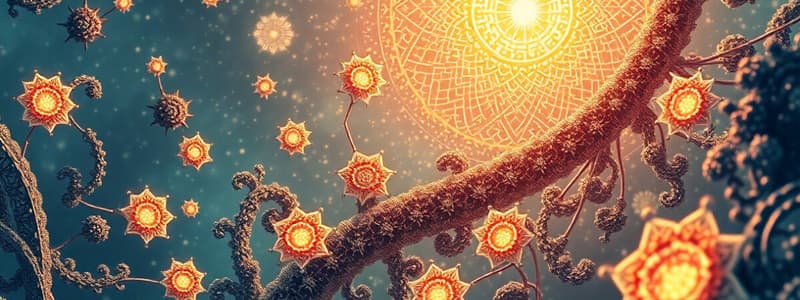Podcast
Questions and Answers
What is a nanometer?
What is a nanometer?
- One millionth of a meter
- One billionth of a meter (correct)
- A unit of weight measurement
- A unit of time measurement
Who coined the term 'nanotechnology'?
Who coined the term 'nanotechnology'?
- Richard P. Feynman
- Niels Bohr
- Norio Taniguchi (correct)
- Albert Einstein
What significant advancement occurred in 1981 related to nanotechnology?
What significant advancement occurred in 1981 related to nanotechnology?
- Invention of the scanning tunneling microscope (correct)
- Creation of silver nanoparticles
- Establishment of commercial nanotechnology applications
- Discovery of carbon nanotubes
What application of nanotechnology was noted in the early 2000s?
What application of nanotechnology was noted in the early 2000s?
What is the approximate width of a human hair in nanometers?
What is the approximate width of a human hair in nanometers?
Which of the following terms best describes nanotechnology?
Which of the following terms best describes nanotechnology?
What size is a buckyball in nanometers?
What size is a buckyball in nanometers?
Which of the following is the correct order of sizes from macro to nano?
Which of the following is the correct order of sizes from macro to nano?
What is the primary characteristic of nanorods when synthesized from metals or semiconducting materials?
What is the primary characteristic of nanorods when synthesized from metals or semiconducting materials?
Which of the following is NOT an application of nanobots?
Which of the following is NOT an application of nanobots?
In which approach does molecular self-assembly occur?
In which approach does molecular self-assembly occur?
What is a feature of the top-down approach in nanotechnology?
What is a feature of the top-down approach in nanotechnology?
Which of the following materials is known for its hydrophobic and dirt-repellent properties?
Which of the following materials is known for its hydrophobic and dirt-repellent properties?
What is a benefit of nanobots being microscopic in size?
What is a benefit of nanobots being microscopic in size?
What property is associated with gold ion in nanotechnology applications?
What property is associated with gold ion in nanotechnology applications?
Which of the following describes a situation where the bottom-up approach is applied?
Which of the following describes a situation where the bottom-up approach is applied?
What is one of the potential uses of nanotechnology in transportation?
What is one of the potential uses of nanotechnology in transportation?
What is a significant risk associated with the use of nanoparticles?
What is a significant risk associated with the use of nanoparticles?
What is the potential advantage of nanorobotics compared to human tasks?
What is the potential advantage of nanorobotics compared to human tasks?
Which field may develop due to advances in nanotechnology aimed at medical repair?
Which field may develop due to advances in nanotechnology aimed at medical repair?
What is a described danger of the 'nano-bomb' according to the content?
What is a described danger of the 'nano-bomb' according to the content?
What phenomenon does the term 'GRAY GOO' relate to?
What phenomenon does the term 'GRAY GOO' relate to?
What are aerogels primarily recognized for in their applications?
What are aerogels primarily recognized for in their applications?
What potential future development is associated with nanotechnology?
What potential future development is associated with nanotechnology?
What is a major advantage of using carbon nanotubes in computer components?
What is a major advantage of using carbon nanotubes in computer components?
What is formed at the intersections of perpendicular nanowires in a memory device?
What is formed at the intersections of perpendicular nanowires in a memory device?
Which technology is being explored for reducing the size of microprocessors?
Which technology is being explored for reducing the size of microprocessors?
What is the diameter of a carbon nanotube?
What is the diameter of a carbon nanotube?
Which of the following materials is NOT mentioned as a component of cutting tools made with nanotechnology?
Which of the following materials is NOT mentioned as a component of cutting tools made with nanotechnology?
How do magnetic nanowires contribute to memory device density?
How do magnetic nanowires contribute to memory device density?
What role do silver nanocrystals play in medical applications?
What role do silver nanocrystals play in medical applications?
Which company is developing a memory device using nanowires coated with titanium dioxide?
Which company is developing a memory device using nanowires coated with titanium dioxide?
What advantage does nanotechnology offer in drug delivery for cancer treatments?
What advantage does nanotechnology offer in drug delivery for cancer treatments?
Which of the following is a benefit of using nanotechnology in fabrics?
Which of the following is a benefit of using nanotechnology in fabrics?
How do nanobots function in medical treatments like cancer?
How do nanobots function in medical treatments like cancer?
What is one application of nanotechnology in mobile phone development?
What is one application of nanotechnology in mobile phone development?
What impact does nanotechnology have on the electronics industry?
What impact does nanotechnology have on the electronics industry?
Which of the following uses of nanotechnology specifically improves resistance to dirt and stains in clothing?
Which of the following uses of nanotechnology specifically improves resistance to dirt and stains in clothing?
What role does nanolithography play in electronics manufacturing?
What role does nanolithography play in electronics manufacturing?
How does nanotechnology contribute to defense and security applications?
How does nanotechnology contribute to defense and security applications?
Flashcards are hidden until you start studying
Study Notes
Nanotechnology Definition
- The study and application of controlling matter at the atomic and molecular level.
- Enables the engineering and construction of functional systems at the micro and nanoscale.
Size Comparison
- A nanometer is one billionth of a meter, roughly the width of three or four atoms.
- The average human hair is about 25,000 nanometers wide.
- MACRO:
- A person is roughly 2 billion nm tall.
- An apple is almost 80 million nm.
- An ant is roughly 5 million nm.
- MICRO:
- The diameter of a human hair is 75,000 nm.
- Everything visible to the naked eye is 10,000 nm.
- DNA is 2 nm.
- E.coli bacteria is 2,000 nm.
- NANO:
- A buckyball is 1 nm.
- The diameter of a carbon nanotube is 1.3 nm.
History
- The first concept of nanotechnology was presented in 1959 by Dr. Richard P. Feynman.
- The invention of the scanning tunneling microscope in 1981 and the discovery of fullerene (C60) in 1985 propelled the field forward.
- The term "nanotechnology" was coined by Norio Taniguchi in 1974.
Nanomaterials
- Nanorods (quantum dots):
- Dimensions range from 1-100 nm.
- May be synthesized from metals or semiconducting materials.
- Used in display technologies, MEMS, and cancer therapeutics.
- Nanobots:
- Close to the scale of 10^-9.
- Capable of counting specific molecules in a chemical sample.
- Can perform microscopic and macroscopic tasks in large numbers.
- Can potentially replicate using environmental resources.
- Applications include environmental toxin detection, drug delivery, and biomedical instrumentation.
Approaches to Nanotechnology
- Bottom-up:
- Building materials and devices from molecular components that self-assemble through chemical recognition.
- Examples include Watson-Crick base pairing and nano-lithography.
- Top-down:
- Creating nano-objects and materials by reducing larger entities without manipulation at the atomic level.
- Less practiced than the bottom-up approach.
- Solid-state techniques are used to create nanoelectromechanical systems (NEMS) or microelectromechanical systems (MEMS).
Materials Used in Nanotechnology
- Zinc oxide:
- Dirt repellent, hydrophobic, cosmetics & stain resistance.
- Silver ion:
- Healing property.
- Aluminum silicate:
- Scratch resistance.
- Gold ion:
- Chip fabrication, drug delivery.
Applications of Nanotechnology
- Nanobio-technology: manipulating biological systems at the nanoscale.
- Medicine & Drugs:
- Targeted drug delivery, improved diagnostics, and new therapies.
- Nanobots can clear blockages in arteries, deliver drugs to specific tumor sites, and offer targeted treatment for various diseases.
- Energy:
- Enhancing solar cells, fuel cells, and energy storage.
- Nano Devices:
- Building smaller, faster, and more efficient electronic components.
- Optical Engineering:
- Development of new optical materials and devices, including tunable lenses and advanced sensors.
- Defence & Security:
- Enhancing armor materials, creating new surveillance technologies, and developing advanced weapons systems.
- Bio Engineering:
- Creating new biomaterials, engineering synthetic tissues, and developing gene therapies.
- Cosmetics:
- Creating cosmetics with enhanced properties like sun protection, anti-aging, and wrinkle reduction.
- Nano Fabrics:
- Improving fabric properties like water resistance, stain resistance, and antimicrobial activity.
Nanotechnology in Electronics
- Electrodes made from nanowires enable thinner and flexible flat panel displays.
- Nanolithography is used for chip fabrication.
- Transistors made from nanowires can be assembled on glass or flexible plastic for applications like e-paper, displays on sunglasses, and map displays on car windshields.
Nanotechnology in Computers
- Carbon nanotubes are being explored as replacements for silicon transistors in computer chips, offering smaller, faster, and more energy-efficient components.
- Nanorods are a promising technology for displays due to lower energy consumption and heat emission.
- Nanodots (magnetic nanoparticles) are being researched for high-density memory devices.
- Memristors, created by intersecting nanowires coated with titanium dioxide, offer potential for high-density memory chips.
Advantages of Using Carbon Nanotubes in Electronics
- Faster and smaller components.
- Reduced energy consumption.
- High speed and high capacity memory.
- More accurate circuits at the atomic level.
Other Applications of Nanotechnology
- Cutting tools made of nanocrystalline materials are more durable and wear-resistant.
- Silver nanocrystals are used in bandages to kill bacteria and prevent infection.
- Nanoparticulate-based synthetic bone is formed by manipulating calcium and phosphate at the molecular level.
- Aerogels, the lightest known solid, are used in space suits and are proposed for spacecraft due to their good insulating properties.
Potential Future of Nanotechnology
- The development of lighter, stronger, and programmable materials with improved energy efficiency.
- The emergence of nanorobotics with potential for human tasks and currently impossible feats.
- The possibility of rebuilding the depleted ozone layer.
- The creation of a nano surgical field for treating various conditions, including aging, diabetes, and bone spurs.
- The potential for almost universal repair through nano surgery.
Pitfalls of Nanotechnology
- Nanoparticles can enter the body through skin, lungs, and digestive system, potentially causing cell damage through free radicals.
- Nanoparticles can cross the blood-brain barrier, potentially leading to unknown effects on the brain.
- The development of self-replicating nanobots could pose a threat to the environment, potentially leading to uncontrollable growth ("Grey Goo").
- The military potential of manufactured deadly viruses contained in nano-bombs raises ethical concerns.
Bottom Line
- Nanotechnology holds tremendous potential for advancements across various fields.
- The ability to manipulate matter at the atomic level opens up exciting possibilities for the future.
Studying That Suits You
Use AI to generate personalized quizzes and flashcards to suit your learning preferences.




